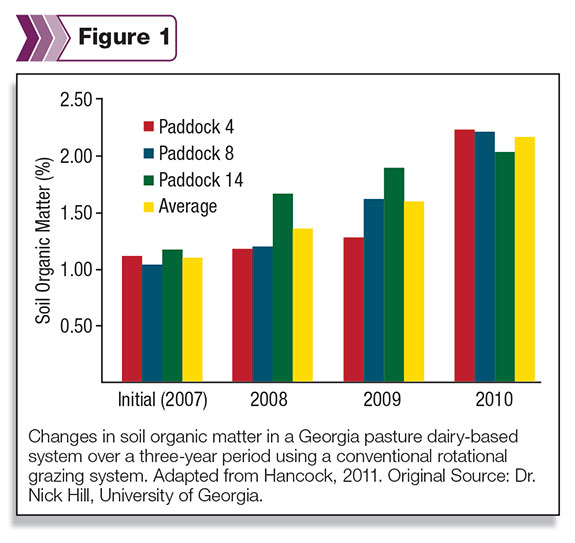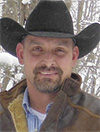The grazing period could range from a full day to a few hours a day. This concept is based on the same principle as management- intensive grazing (MIG), but with much longer rest periods.
Three major goals of UHSD include: Shortening the grazing period, increasing the length of the rest period and increasing stock density to optimize gain per acre.
Mob grazing advocates have reported better nutrient distribution, weed control, soil quality (increase in organic matter), pasture composition, and uniform grazing and forage utilization.
One uncertainty of this system is that most information is based on testimonials and not scientifically- collected data.
Although UHSD could allow for more uniform nutrient distribution and more effective nutrient cycling, the same goals could be achieved with rotational grazing.
Previous studies predict that it might take 27 years to place a pile of manure per every 10 square feet in the pasture, while UHSD could take less than two years.
The same differences can be seen in the transition from continuous to rotational grazing once shade and water are strategically placed in the paddock to avoid spot grazing.
Weed control is a battle in any grazing system. Although pictures that I have seen in some presentations about mob grazing and in live demonstrations indicate that cows are eating all kind of weeds present in the grazing area, the same could be achieved with a rotational grazing system where those weeds are kept in a vegetative stage instead of the reproductive stage.
Keep in mind that some weeds can also become more toxic at maturity and cause health issues because under mob grazing they cannot be as selective as using a more conventional rotational grazing system.
One disadvantage of having a large number of animals in a small area is that it usually causes trampling of the forage, and the hoof action could speed up oxidation of organic matter and therefore decrease carbon sequestration.
There is very limited data on the impact of this system on soil bulk density as well as water infiltration rates.
There are claims that soil organic matter can increase from 2 percent to 9 percent in a few years (although the numbers seem possible, I am a little skeptical).
This might not be a true statement for the Deep South because of the longer growing season with elevated soil temperatures and high humidity; microbial activity increases carbon oxidation and could have an impact in carbon sequestration rates.

Data from University of Georgia using dairy farms have observed that short rest periods of 20 to 25 days (conventional, management-intensive grazing) only have a yearly average increase organic matter of 0.35 percent per year (Figure 1).
Another issue is that the mob grazing system being promoted is not based on the concept of harvesting high-quality forage.
An area might be grazed only a few times a year, and the animals are forced to eat fully matured, low-quality forage.
Mature forage is usually high in lignin and cellulose, which limits forage intake.
Keep in mind that energy requirements change during lactation to pregnancy and depending on the type of livestock being grazed.
Based on the long rest periods, mob grazing cannot be used year-round by producers with limited forage diversity in their operation, but it could be used a few months a year when rapid forage growth is favored.
In Mississippi, this could be a practical approach in the spring when annual ryegrass reaches peak growth. This could also help to open the canopy for warm-season grasses to break dormancy and be able to compete earlier in the season.
Another approach will be with native warm-season grasses such as switchgrass, where rapid growth could significantly affect forage quality.
The system can be managed with even a single strand of electric fence. This is similar to rotational grazing where electric fences could be used to improve forage utilization.
Mob grazing is applied under the concept of high stock density. Stock density is defined as the number of pounds of beef per acre at a given point in time.
This does not mean a higher stocking rate (the average number of animals for a given area for the whole year). This means that if you have a herd of 50 dry cows with average weight of 1,000 pounds on 10 acres, that’s 50,000 pounds on the hoof.
Divide pounds per acre (50,000 / 10), and that will define the stock density, in this case 5,000 pounds of live weight per acre.
If this herd is placed in two acres, then the stocking density will be 25,000 pounds per acre. Put them in half an acre and the stock density is 100,000 pounds per acre.
Based on this calculation, producers might ask: What is a good stocking density? A high stocking density generally ranges from 50,000 to 250,000 pounds per acre while an ultra-high stock density system could be 250,000 pounds or higher (depending on the grazing intensity).
Remember that while a producer might be using this high stock density, the mob grazing approach recommends not using more than 60 percent (50 to 60 percent range) utilization.
Advocates of the system suggest that limiting utilization will allow the trampling of vegetation, creating a “mulch effect,” and will allow for plant recovery. But the utilization rate is similar to a rotational grazing system in which livestock is moved weekly or monthly.
A pasture that is only grazed every 90 days will have higher yields, but it could have digestibility that is less that 45 percent, while a pasture that is grazed every 25 days could have over 60 percent digestibility.
This is an indication that this rapid movement might not be increasing efficiency and could compromise animal performance.
Remember that it is very important to balance between yield and quality to provide a competitive edge. Since mob grazing can be used a few months a year, how is that different from stockpiling forages in the fall to extend the grazing season and minimize feeding hay?
If the forage is too tall or too short, animals will not be able to consume enough during the time they will graze each day to meet their nutritional needs.
One major limitation to mob grazing could be water placement. Not all pastures might have easy water access, which means portable water systems will have to be put in place to meet their water requirements.
With a conventional grazing system, a pond could provide easy water accessibility to the animal once the fences and rotations are put in place, or a more permanent water system could be installed once the layout of the rotational grazing system is defined.
This is not usually the case with mob grazing because grazing plans are defined based on stock densities and not stocking rates. This means paddock sizes under mob grazing are highly variable.
Pasture production is affected by grazing animals. Stocking rate and grazing method are the two most important management variables affecting forage production, seasonal pattern of production, forage quality and botanical composition.
The purpose of this article was to stimulate some thinking about the pros and cons mob grazing might present when compared to a conventional rotational grazing system.
Although mob grazing might have some advantages and disadvantages over other grazing management systems, it is not a system that will fit everyone’s livestock operation and it has its place in certain regions.
To be successful, a producer needs to be a good manager and understand the principles of intensive rotational grazing and develop the habit of having consistency with the system.
Some other grazing experts compare mob grazing at the same level of time and energy required by a dairy operation. This is something that requires more dedication and is more labor-intensive.
They need to monitor plant growth and only graze the areas after they have had adequate plant recovery, which holds true for other types of grazing systems.
Producers also need to monitor livestock body score conditions and animal performance to ensure that forage quantity and quality are meeting daily livestock requirements.
Keep in mind that a sound management grazing system needs to meet the nutritional needs of whatever livestock class is present on the farm; optimize forage yield, quality and persistence; and utilize the appropriate management approach to develop a practical, economical, sustainable and environmentally friendly grazing system. FG
—Excerpts from Mississippi State University newsletter Forage News, Volume 4, Issue 7, July 2011
Rocky Lemus
Extension Forage Specialist
Mississippi State University









